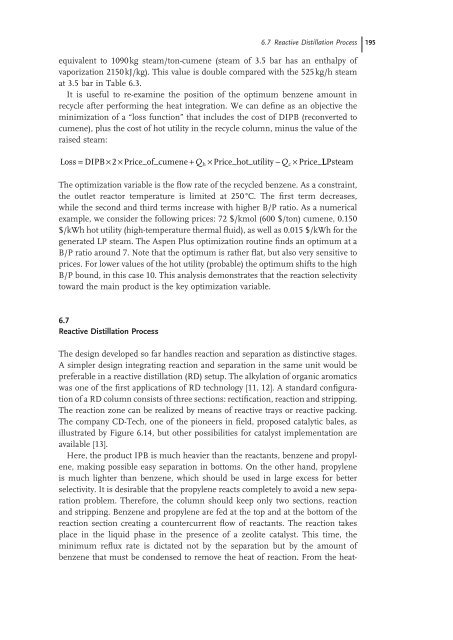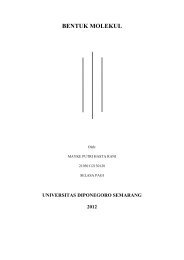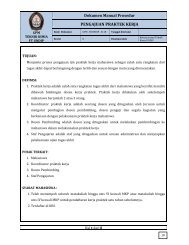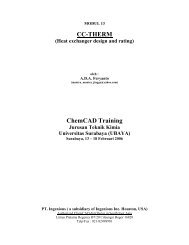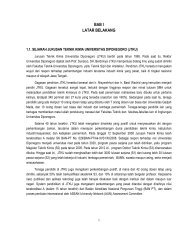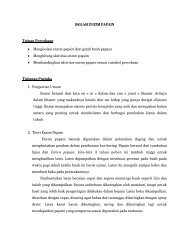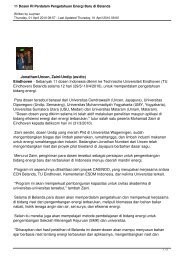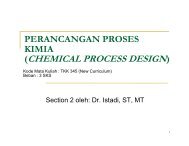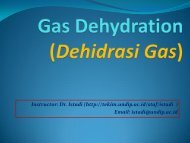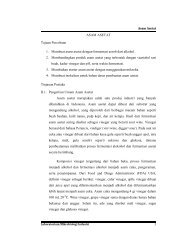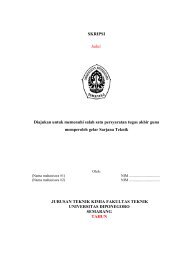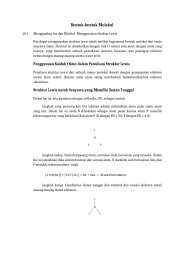Alkylation of Benzene by Propylene to Cumene 6
Alkylation of Benzene by Propylene to Cumene 6
Alkylation of Benzene by Propylene to Cumene 6
- No tags were found...
You also want an ePaper? Increase the reach of your titles
YUMPU automatically turns print PDFs into web optimized ePapers that Google loves.
equivalent <strong>to</strong> 1090 kg steam/<strong>to</strong>n - cumene (steam <strong>of</strong> 3.5 bar has an enthalpy <strong>of</strong>vaporization 2150 kJ/kg). This value is double compared with the 525 kg/h steamat 3.5 bar in Table 6.3 .It is useful <strong>to</strong> re - examine the position <strong>of</strong> the optimum benzene amount inrecycle after performing the heat integration. We can define as an objective theminimization <strong>of</strong> a “ loss function ” that includes the cost <strong>of</strong> DIPB (reconverted <strong>to</strong>cumene), plus the cost <strong>of</strong> hot utility in the recycle column, minus the value <strong>of</strong> theraised steam:Loss = DIPB × 2 × Price_<strong>of</strong>_cumene + Q × Price_hot_utility − Q × Price_ LPsteamh6.7 Reactive Distillation Process 195The optimization variable is the flow rate <strong>of</strong> the recycled benzene. As a constraint,the outlet reac<strong>to</strong>r temperature is limited at 250 ° C. The first term decreases,while the second and third terms increase with higher B/P ratio. As a numericalexample, we consider the following prices: 72 $ /kmol (600 $ /<strong>to</strong>n) cumene, 0.150$ /kWh hot utility (high - temperature thermal fluid), as well as 0.015 $ /kWh for thegenerated LP steam. The Aspen Plus optimization routine finds an optimum at aB/P ratio around 7. Note that the optimum is rather flat, but also very sensitive <strong>to</strong>prices. For lower values <strong>of</strong> the hot utility (probable) the optimum shifts <strong>to</strong> the highB/P bound, in this case 10. This analysis demonstrates that the reaction selectivity<strong>to</strong>ward the main product is the key optimization variable.c6.7Reactive Distillation ProcessThe design developed so far handles reaction and separation as distinctive stages.A simpler design integrating reaction and separation in the same unit would bepreferable in a reactive distillation (RD) setup. The alkylation <strong>of</strong> organic aromaticswas one <strong>of</strong> the first applications <strong>of</strong> RD technology [11, 12] . A standard configuration<strong>of</strong> a RD column consists <strong>of</strong> three sections: rectification, reaction and stripping.The reaction zone can be realized <strong>by</strong> means <strong>of</strong> reactive trays or reactive packing.The company CD - Tech, one <strong>of</strong> the pioneers in field, proposed catalytic bales, asillustrated <strong>by</strong> Figure 6.14 , but other possibilities for catalyst implementation areavailable [13] .Here, the product IPB is much heavier than the reactants, benzene and propylene,making possible easy separation in bot<strong>to</strong>ms. On the other hand, propyleneis much lighter than benzene, which should be used in large excess for betterselectivity. It is desirable that the propylene reacts completely <strong>to</strong> avoid a new separationproblem. Therefore, the column should keep only two sections, reactionand stripping. <strong>Benzene</strong> and propylene are fed at the <strong>to</strong>p and at the bot<strong>to</strong>m <strong>of</strong> thereaction section creating a countercurrent flow <strong>of</strong> reactants. The reaction takesplace in the liquid phase in the presence <strong>of</strong> a zeolite catalyst. This time, theminimum reflux rate is dictated not <strong>by</strong> the separation but <strong>by</strong> the amount <strong>of</strong>benzene that must be condensed <strong>to</strong> remove the heat <strong>of</strong> reaction. From the heat -


